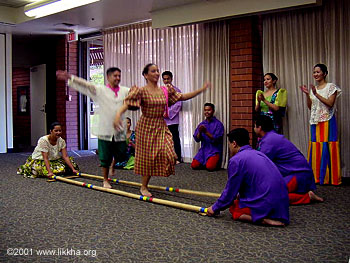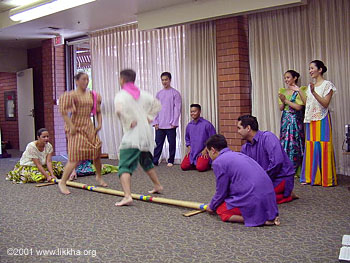Tinikling Ideas
Description
of Activity
Tinikling is the most popular and best known dance of the Philippines,
receiving acclaim as their national dance. The dance is similar to rope jumping,
but instead of a spinning rope, two bamboo poles are hit against raised blocks
on the floor and then together. Tinikling actually means "bamboo dance" in
English. The dance requires one person to operate each end of the poles, and
one or more dancers to move in and out of the poles.

Photo taken by Divine Marcelo © 2001 Likha Pilippino Folk
Ensemble. Check out their website at www.likha.org/galleries/tinikling.asp.
Origin
Tinikling originated in the Visayan Islands, on the Island
of Leyte. Dancers imitate the tikling bird's legendary grace and speed as
they walk between grass stems, run over tree branches, or dodge bamboo traps
set by rice farmers.
Different stories of tinikling have been passed down through
oral histories and folklore. One of the stories of it's origin may or may
not be true. The story says that the dance started by the people who worked
on the fields and paddies in the Philippines. When the Spaniards conquered
the Philippines, the natives were sent to the haciendas. The natives lost
control of their land because they were under an economic system that is largely
based on rural and agricultural operations of large farmlands administered
by caretakers for the King of Spain. The natives had to work all day to please
the Spaniards. The people of the Philippines worked in the fields and paddies
for almost four hundred years (1500-1898). The people who worked too slowly
would be punished. Their punishment was to stand between two bamboo poles
cut from the grove. Sometimes, the sticks would have thorns jutting out from
their segments. The poles were then clapped together to beat the native's
feet. By jumping when the bamboo sticks were apart, the natives tried to escape
this cruel form of punishment.
The matrix for the dance was probably laid out when the workers
would return home with their feet bruised and bleeding from the punishment.
By practicing to escape the bamboo sticks during punishment, tinikling soon
became a challenge, an art, and a dance. Now tinikling is performed on certain
Sundays in the Philippines. Since it is no longer a punishment, the sticks
are smooth and the clapping is gentle.

Photo taken by Divine Marcelo © 2001 Likha Pilippino Folk
Ensemble. Check out their website at www.likha.org/galleries/tinikling.asp.
Equipment
Tinikling equipment may be bought commercially, but is more
economical to supply yourself. The following items work well and are inexpensive:
1. Wooden closet dowels from the local lumber yard (8-18 feet long, depending
on number of dancers).
2. Pieces of free 2x4 scrap or inexpensively bought 2x4's may be cut as
blocks (approximately 30 inches long).
3. Free carpeting samples may be cut up and glued to the bottom of block
ends to protect wood floors and to decrease vibrating of blocks when they
are hit.
4. Tape marks may be placed on blocks to approximate the width to separate
the poles to hit them on the blocks (14-18 inches apart, depending on size
of dancers).
1. Clap to self - Have movers simulate the 4/4 tinikling beat by slapping
hands against their thighs for two beats, and then clapping hands together
for two beats. The cadence is "down, down, together, together"
or "slap, slap, clap, clap."
2. Clap with foursome - With all facing the middle of the foursome, have
students slap hands against their thighs for two beats, and then clap hands
against their neighbor's hands on either side for two beats.
3. Clap poles with partner without dancers.
| SAFETY
NOTE: The last 6 inches of each pole should be wrapped with tape to
prevent slivers when operating poles. Pole operators need to keep
their faces back in case a dancer steps on a pole, springing it into
the air. The best positions to ensure this are (a) sitting on floor
with legs apart, or (b) crouching down on one knee. |
4. Practice basic steps with poles still on floor.
5. When music is introduced, instrumental music has a more defined beat
than does music with lyrics.
Types of steps
Tinikling dance steps are usually described as combinations
of only three basic 4/4 steps: Singles, doubles, and hops.
Singles and doubles refer to the number of feet that touch the
floor at a time during a given step. Hops refers to a specific category
of singles steps, although sometimes a step involving just one foot at a time
actually contains a leap, since the body weight is transfered from one foot
to the other foot. The selected steps that follow are described and demonstrated
via video according to the specific nature of the steps, rather than simply
the number of feet involved:
|
|
Descriptions
and video clips of doubles steps |
|
Descriptions and video clips of combination
steps |
|
Descriptions and video clips of singles
steps |
In addition to video clips of steps, the following links provide printer
friendly descriptions of groups of steps, along with a tinikling card on which
students may chart their progress. The card may be downloaded and copied on
cardstock for use in class. After
mastering basic steps, students may sequence steps together into a routine.
Each "poster card" contains one of the 13 steps enlarged for posting
on the wall. Cards may be copied on cardstock and laminated for long term
use. "Pole arrangements" describes alternative ways to position
poles, particularly for creating small or large group patterns.
Additional Challenge
Band jumping is
a rhythmic activity that resembles tinikling. The difference is that the "jump
bands" are elastic bands that have a loop at each end. Consequently, they
are operated by foot, instead of by hand. Those operating the bands put a
loop on each foot and create parallel bands which open and close to the beat.
Dancers move in and out of the bands using a variety of steps or movements
as with the poles.
Either jump bands or tinikling poles may
be used with 3/4 music, as was originally done, however the 4/4 meter is easier
for dancers to follow, and 4/4 music is much more plentiful.
© Steven A. Henkel, 4/06

